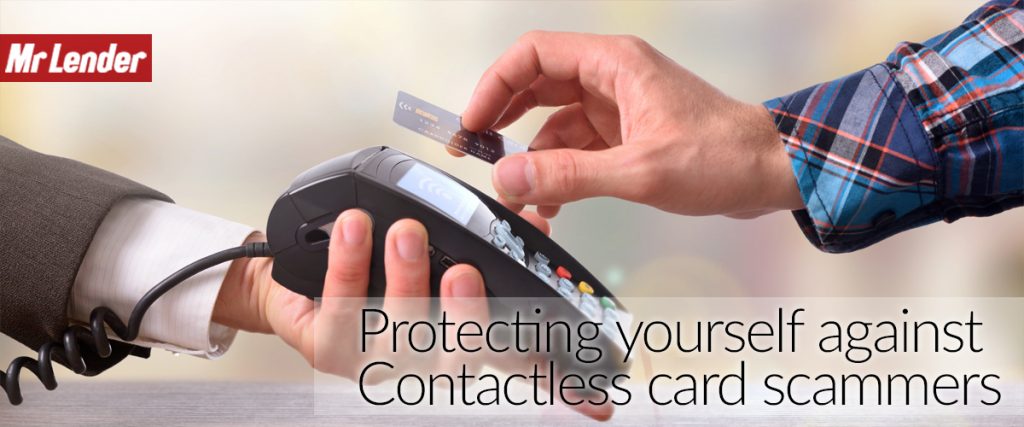
We all know the basic ways to protect ourselves from scammers and fraudsters; never share your password with anyone, don’t click dodgy links in emails and never ever respond to that ‘lawyer’ who’s discovered your long-lost cousin one hundred times removed on your aunt Doris’ dog’s side of the family is a foreign prince who wants to share his millions with you but he just needs all your bank details first.
But what if the tricksters can hit us while we’re walking down the street, without us even knowing about it?
The introduction of contactless bank cards has made shopping and dining out a lot easier for many of us. But it’s also brought with it a new wave of fraud; electronic pickpocketing.
Electronic pickpocketing is leaving us so vulnerable to theft that some police forces have started handing out protective sleeves to residents. The move comes after they saw a rise in criminals using handheld electronic readers to skim people’s card details.
Here at Mr Lender we don’t think there’s too much to panic about – and we’ve put together a guide and some tips to help keep your hard-earned money safe:
How am I at risk?
Thieves can swipe money from your account while you browse the shops, sit on the train or walk down the street – and you won’t know anything about it until you spot the transaction on your statement – if you do even spot it.
Currently you can spend up to £30 on a contactless card without the need to input your pin, and there’s talk of raising the limit to £50.
The problem is that these small chunks of cash are not easily missed from some bank accounts. If £500 was swiped from your account you’d probably spot it straight away – but would you pick up on £30 here and there so easily?
How can people take my money without me noticing?
Businesses can buy card-reading machines online for as little as £30. They’re not intended for criminal use but there are no restrictions on who buys them, and at the size of a smartphone they’re easily concealed. In the wrong hands, the mobile devices can be used to process a fake transaction using your card. The machine only needs to be around 4 inches away from your card – so the user can hover it next to your bag or pocket as you stand in a queue or sit on the bus without you even noticing.
Consumer group Which? has also revealed someone standing close to a contactless enabled card can easily ‘lift’ sensitive account details using card readers readily available online.
Once in possession of your name, card number and expiry date, a crook with the right equipment has enough to commit identity fraud in shops and online.
This happened to Hannah Willsher. She says:
“I used my first contactless card – a credit card – to buy some shopping. A week later I found hundreds of pounds coming out of my bank account. I phoned my bank to question it and it turned out someone had cloned my card and started using it regularly at a department store in London.
Then when I was waiting to pay for my dinner in a restaurant I put my card on the table ready. As the waitress walked towards me her machine beeped and she told me my payment had gone through. She was a good few metres away so I hadn’t been able to check the amount. I’m very careful using them now and I get anxious taking them out with me.”
Jo Coldwell also hit a snag while dining out. She says:
“My friend and I split the bill. We both placed our cards on top of the bill on a small plate and the waitress asked if it was okay to ‘ping’ the cards for payment. We agreed and carried on chatting. It wasn’t until we got home I realised the waitress had picked my card up, pinged it for cash, put it down and then instead of picking my friend’s card up, picked mine up again. So I ended up paying both halves of the bill.”
And if your card is stolen, thieves can keep spending money on it even after you’ve cancelled it. This is because a lot of retailers store up payments in a batch and then send them off to be processed ‘online’ with the bank later – usually overnight but sometimes a few days later. This gives a fraudster time to spend money on a stolen card before it’s flagged up.
So what can you do to protect yourself?
Unfortunately there’s no sure-fire way to protect yourself from these scammers – but there are lots of things you can do which will stop you being so vulnerable:
* Mobile devices can work 4 inches away from a card – so don’t leave your bag hanging over your chair when you’re sitting in a bar or restaurant.
* Never keep your card loose in your jacket pocket, or carry your wallet in the back pocket of your trousers.
* It sounds a bit futuristic and you might get some funny looks, but Which? suggests wrapping your bank cards in tin foil or lining your wallets with it. Apparently this blocks the contactless signal emitted by the card and stops it being read by machines – either accidentally by retailers and restaurateurs, or by criminals. It could get annoying having to unwrap your card every time you want to pay for something, but on the bright side it might make you stop and think before every purchase and could end up curbing your spending!
- Defender Note offers A5 pieces of plastic that can be cut to size and placed inside wallets. Just like the tin foil, it blocks any signals. So the contactless technology won’t work unless you take it out. Amazon also has an array of protective sleeves for sale which will protect your cards.
- We’ve heard of people being charged twice when they’re using the London Underground; it’s so handy to ‘tap’ your wallet on the reader at the ticket barrier instead of faffing about getting your Oyster card out – but be careful your contactless card doesn’t get charged at the same time.
- You could always go back to an old-school bank card – most banks will send you a new card without the contactless technology if you request one.
- Check your bank statements regularly and thoroughly. Once a month might seem okay, but can you account for all those smaller payments? It’s wise to keep track so you can be sure all those £30 purchases here and there were made by you. And remember, the contactless cards can still be used after you’ve cancelled them with the bank – so it’s even more important to keep an eye on your statements if your card is lost or stolen.
What if someone does manage to use or clone my card?
The good news is there’s full protection against fraud losses on contactless cards. Your provider will refund money lost through fraudulent contactless payments, as long as you’ve acted reasonably to keep your card safe.

